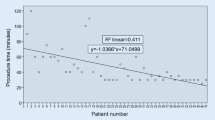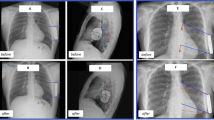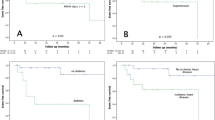Abstract
Objectives
The subcutaneous implantable cardioverter defibrillator (S-ICD®) has been established as an alternative to conventional transvenous ICD for the prevention of sudden cardiac death. Initial studies have shown safety and efficacy of the system with a left parasternal (LP) electrode. However, several case studies reported a right parasternal (RP) position. The purpose of this study was to analyze shock efficacy and safety of an RP electrode position.
Methods
Between June 2010 and May 2016, 120 S-ICD® were implanted at our institution. On the basis of the heart location on preoperative chest radiography (CXR), the investigators decided on an RP (n = 52) or LP electrode position (n = 68). All perioperative induced VF episodes, and spontaneous appropriate and inappropriate episodes during follow-up were analyzed.
Results
Patients with an RP electrode did not differ in terms of age, sex, or ejection fraction. A statistically significant difference in underlying cardiac disease was observed between the RP and LP electrode group, with more patients with channelopathies in the RP electrode group and more patients with non-ischemic cardiomyopathy in the LP electrode group. During a mean follow-up of 24.3 ± 19.5 months, 27 appropriate (19 in the LP group and 8 in the RP group) and 28 inappropriate (18 LP and 10 RP) ICD shocks occurred (p value = NS).
Conclusions
In the present study, an RP electrode position was chosen on the basis of chest radiographic characteristics and was efficient in terms of sensing and shock efficacy. Thus, a right-sided electrode implant might be an alternative if a left-sided electrode implant is inadequate. It might also be favorable for young patients with narrow heart silhouettes in the midsagittal position.




Similar content being viewed by others
Abbreviations
- ACHD:
-
Adult congenital heart disease
- ATP:
-
Antitachycardic pacing
- CAD:
-
Coronary artery disease
- DCM:
-
Dilative cardiomyopathy
- ICD:
-
Implantable cardioverter defibrillator
- HCM:
-
Hypertrophic cardiomyopathy
- SCD:
-
Sudden cardiac death
- S-ICD® :
-
Subcutaneous implantable cardioverter defibrillator
- VF:
-
Ventricular fibrillation
- VT:
-
Ventricular tachycardia
References
Moss AJ, Hall WJ, Cannom DS et al (1996) Improved survival with an implanted defibrillator in patients with coronary disease at high risk for ventricular arrhythmia. Multicenter automatic defibrillator implantation trial investigators. N Engl J Med 335:1933–1940
Moss AJ, Zareba W, Hall WJ et al (2002) Prophylactic implantation of a defibrillator in patients with myocardial infarction and reduced ejection fraction. multicenter automatic defibrillator implantation trial II investigators. N Engl J Med 346:877–883
Bardy GH, Lee KL, Mark DB et al (2005) Amiodarone or an Implantable Cardioverter-Defibrillator for Congestive Heart Failure. N Engl J Med 352:225–237
Bardy GH, Smith WM, Hood MA et al (2010) An entirely subcutaneous implantable cardioverter-defibrillator. N Engl J Med 363:36–44
Burke MC, Gold MR, Knight BP et al (2015) Safety and efficacy of the totally subcutaneous implantable defibrillator: 2-year results from a pooled analysis of the IDE study and EFFORTLESS registry. J Am Coll Cardiol 65:1605–1615
Priori SG, Blomström-Lundqvist C, Mazzanti A et al (2015) 2015 ESC Guidelines for the management of patients with ventricular arrhythmias and the prevention of sudden cardiac death: the task force for the management of patients with ventricular arrhythmias and the prevention of Sudden Cardiac Death of the European Society of Cardiology (ESC). Europace 17(11):1601–1687
Zumhagen S, Grace AA, O’Connor S et al (2012) Totally subcutaneous implantable cardioverter defibrillator with an alternative, right parasternal, electrode placement. Pace 35:e254–e257
Waller JR, Salmon AP, Roberts PR (2015) A right-sided subcutaneous implantable cardioverter defibrillator in a patient with congenital heart disease. Europace 17(1):77
Kaczmarek KA, Winter J, Wranicz JK, Ptaszynski PA (2015) Atypical position of subcutaneus implantable cardioverter-defibrillator as a solution in hypertrophic cardiomyopathy patient with initially negative electrocardiographic screening. Eur Heart J 36(37):2542
Wilson DG, Zeb M, Veldtman G, Dimitrov BD, Morgan JM (2015) Left and right parasternal sensing for the S-ICD in adult congenital heart disease patients and normal controls. Pacing Clin Electrophysiol 39(3):282–290
Okamura H, McLeod CJ, DeSimone CV et al (2016) Right parasternal lead placement increases eligibility for subcutaneous implantable cardioverter defibrillator therapy in adults with congenital heart disease. Circ J 80(6):1328–1335
Groh CA, Sharma S, Pelchovitz DJ et al (2014) Use of an electrocardiographic screening tool to determine candidacy for a subcutaneous implantable cardioverter-defibrillator. Heart Rhythm 11:1361–1366
Frommeyer G, Zumhagen S, Dechering DG et al (2016) Intraoperative defibrillation testing of subcutaneous ICD systems—a simple issue? J Am Heart Assoc 5(3):e003181. https://doi.org/10.1161/JAHA.115.003181
Lambiase PD, Barr C, Theuns DA et al (2014) Worldwide experience with a totally subcutaneous implantable defibrillator: early results from the EFFORTLESS S-ICD registry. Eur Heart J 5(25):1657–1665
Weiss R, Knight BP, Gold MR et al (2013) Safety and efficacy of a totally subcutaneous implantable-cardioverter defibrillator. Circulation 128:944–953
Gold MR, Aasbo JD, El-Chami et al (2017) Subcutaneous implantable-defibrillator post-approval study: clinical characteristics and perioperative results. Heart Rhythm. https://doi.org/10.1016/j.hrthm.2017.05.016
Gold MR, Theuns DA, Knight BP et al (2012) Head-to-head comparison of arrhythmia discrimination performance of subcutaneous and transvenous ICD arrhythmia detection algorithms: the START study. J Cardiovasc Electrophysiol 23:359–366
Randles DA, Hawkins NM, Shaw M, Patwala AY, Pettit SJ, Wright DJ (2014) How many patients fulfil the surface electrocardiogram criteria for subcutaneous implantable cardioverter-defibrillator implantation? Europace 16:1015–1021
Chan NY, Yuen HC, Mok NS (2015) Right parasternal electrode configuration converts a failed electrocardiographic screening to a pass for subcutaneous implantable cardioverter-defibrillator implantation. Heart Lung Circ 24:e203–e205
Schwab JO, Bonnemeier H, Kleemann T et al (2015) Reduction of inappropriate ICD therapies in patients with primary prevention of sudden cardiac death: DECREASE study. Clin Res Cardiol 104:1021–1032
Author information
Authors and Affiliations
Corresponding author
Ethics declarations
Conflict of interest
MB, DD, GF, FR, JK, and LE have received travel grants and lecture honoraria from BIOTRONIK, Boston Scientific, Medtronic, Sorin Group, and St. Jude Medical.
Rights and permissions
About this article
Cite this article
Bettin, M., Dechering, D., Frommeyer, G. et al. Right versus left parasternal electrode position in the entirely subcutaneous ICD. Clin Res Cardiol 107, 389–394 (2018). https://doi.org/10.1007/s00392-017-1194-y
Received:
Accepted:
Published:
Issue Date:
DOI: https://doi.org/10.1007/s00392-017-1194-y




